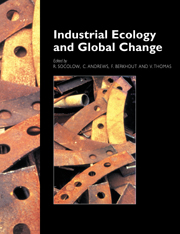Book contents
- Frontmatter
- Contents
- Foreword
- Preface
- Acknowledgments
- Contributors
- OVERVIEW
- PART 1 VULNERABILITY AND ADAPTATION
- PART 2 THE GRAND CYCLES: DISRUPTION AND REPAIR
- PART 3 TOXICS AND THE ENVIRONMENT
- PART 4 INDUSTRIAL ECOLOGY IN FIRMS
- 23 Introduction
- 24 Product Life-Cycle Management to Replace Waste Management
- 25 Industrial Ecology in the Manufacturing of Consumer Products
- 26 Design for Environment: A Management Perspective
- 27 Prioritizing Impacts in Industrial Ecology
- 28 Finding and Implementing Projects that Reduce Waste
- 29 Free-Lunch Economics for Industrial Ecologists
- PART 5 INDUSTRIAL ECOLOGY IN POLICY-MAKING
- END PIECE
- Organizing Committee Members
- Working Groups
- Index
24 - Product Life-Cycle Management to Replace Waste Management
Published online by Cambridge University Press: 04 August 2010
- Frontmatter
- Contents
- Foreword
- Preface
- Acknowledgments
- Contributors
- OVERVIEW
- PART 1 VULNERABILITY AND ADAPTATION
- PART 2 THE GRAND CYCLES: DISRUPTION AND REPAIR
- PART 3 TOXICS AND THE ENVIRONMENT
- PART 4 INDUSTRIAL ECOLOGY IN FIRMS
- 23 Introduction
- 24 Product Life-Cycle Management to Replace Waste Management
- 25 Industrial Ecology in the Manufacturing of Consumer Products
- 26 Design for Environment: A Management Perspective
- 27 Prioritizing Impacts in Industrial Ecology
- 28 Finding and Implementing Projects that Reduce Waste
- 29 Free-Lunch Economics for Industrial Ecologists
- PART 5 INDUSTRIAL ECOLOGY IN POLICY-MAKING
- END PIECE
- Organizing Committee Members
- Working Groups
- Index
Summary
Abstract
As ‘eco-restructuring’ commences, new elements in our waste management infrastructure should be created. These include a redefinition of product types to acknowledge their life-cycle environmental impacts; reallocation of responsibilities between producers and consumers for these products; product redesign for environmental compatibility; source-separation sites or ‘waste supermarkets,’ and accessible repositories or ‘waste parking lots.’
Where We Need to Go
Industry has traditionally focused on production rather than waste management. Over time this has led to the creation of chemicals and products for which no environmentally sound method of disposal exists. Large-scale production has led in turn to significant waste disposal problems. In order to shift from a primitive, low-efficiency type I industrial ecology (see Graedel, this volume) to something more sustainable, a new infrastructure for waste management is required.
Marketplace norms today define products on a spectrum from ‘consumable’ to ‘durable,’ depending on their useful lifetimes. However, to give prominence to environmental factors, it is useful to classify products according to their life-cycle, cradle-to-grave impacts. The crucial distinction is between consumable products and service products.
Consumable products, such as washing powder or food, are purchased to be consumed, i.e., converted by chemical reaction into energy and byproducts. They are normally put out into the natural environment after only one use. Service products, by contrast, are not consumed; rather they provide some service over and over again. Automobiles, television sets, and washing machines are examples of products providing the services of transportation, entertainment, and cleaning. Thinking prescriptively, an ‘eco-restructured’ economy should differentiate its treatment of consumable products and service products.
- Type
- Chapter
- Information
- Industrial Ecology and Global Change , pp. 335 - 338Publisher: Cambridge University PressPrint publication year: 1994
- 7
- Cited by



